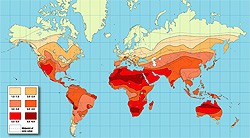This is absolutely not true! PV is deployed on every continent on the globe and will work anywhere that is not subjected to extensive shading. While some regions are fortunate enough to have more sun exposure on average than others, any location that allows sunlight to reach the surface of a PV module will enable it to generate clean, quiet power.
We often describe the solar resource of a given location as “insolation.” Insolation is the amount of energy hitting a defined spot, typically over the course of an average day for that spot. The unit of measure that is most often used to describe the insolation of a place is hours of “peak sun.” This is not to be confused with hours that the sun is shining during the day! Insolation maps can be found online that will show the hours of peak sun per day across the area that the map depicts. Some maps will show annual average daily resource while others will show the expected daily average for a given season since the resource changes as the seasons change.
Places that have less average daily sun exposure, or fewer hours of peak sun per day, will require larger solar arrays to generate the same amount of energy as sunnier locales, but they will still be capable of generating power. Germany is an excellent example of the effectiveness of solar electric systems in a northern climate. With weather patterns that resemble the Pacific Northwest here in the United States, Germany has more installed solar power than nearly any other country on Earth.
Another reason why Solar can work very well in northern climates is because of temperature. A little-known fact about solar power is that heat actually decreases the performance of a solar array, while cold temperatures can enhance an array’s performance. The output voltage of solar modules changes as temperatures fluctuate, and the hotter the module gets, the lower the output voltage becomes. When voltage decreases, the overall power output goes down, resulting in diminished performance of the array. Cold, ambient temperatures found in northern climates can help raise the output voltage of the array, thereby raising the power output of the array as well. When these colder temperatures are combined with sunlight reflecting off of snow and ice, it can really boost the output of a solar electric system. These conditions can help make up for shorter days and cloudy weather which northern locations often experience.
In general, more daily sun exposure will lead to better production from a solar array. That said, solar power will still work in any spot that receives direct sunlight, you just might need a larger solar array to achieve the same results.

